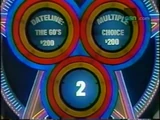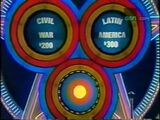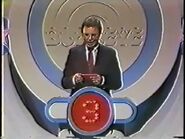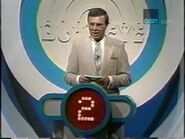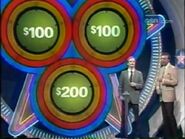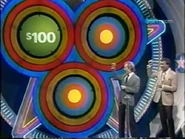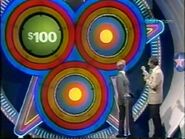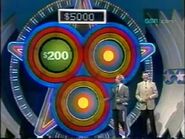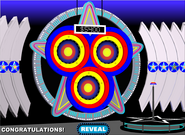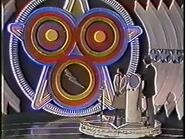| Host | |
| Jim Lange | |
| Announcers | |
| Jay Stewart (1979–1981) Charlie O'Donnell (1981–1982) | |
| Broadcast | |
| Pilot: 11/1979Syndication (Daily): 9/29/1980 – 12/4/1981Syndication (Daily): 12/7/1981 – 6/25/1982 (reruns aired until 9/24/1982) | |
| Packager | |
| Barry & Enright Productions | |
| Distributor | |
| Colbert Television Sales | |
This article is about the Barry & Enright game show. For the 2015 reality show, see Bullseye (2).
(Celebrity) Bullseye was a two-year game show that combined elements of other Barry-Enright shows. It was the game of strategy, knowledge, luck, and especially daring.
Gameplay[]
Main Game[]
Two contestants, one a returning champion, competed. The game began with the champion stopping a star-shaped gameboard of three spinning windows by hitting a three-colored plunger in front of him/her. The first two windows contained eight different categories (four in each window) with dollar amounts ranging from $50 to $200 (representing the value of each question). The third window (below the two category windows) was the Contract window, and displayed numbers from one to five, as well as a "Bullseye" graphic.
When the windows stopped spinning, the contestant chose either of the displayed categories, and had to fulfill the contract by correctly answering the number of questions indicated in the Contract window. If the Contract window contained a Bullseye, the contract was unlimited; the contestant could continue answering questions for as long as he/she wanted. Each correct answer added the value of the question to a pot. A missed question gave the opponent a chance to steal control of the contract with a right answer.
After the contract had been completed, the contestant who completed the contract could elect to either bank the money in the pot, passing control to the opponent, or continue playing with a new contract; choosing the latter option would leave the accumulated money in the pot up for grabs by either player.
The first contestant to bank $1,000 or more won the game. (Beginning with a Nov. 1980 children's charity week, this was increased to $2,000, with question values increasing to $100–$400.) Contestants got to keep any money banked during a game, regardless of the outcome, making Bullseye one of the few Barry & Enright shows to allow losing contestants to keep earnings from the game.
In the event of a champion winning the game without the challenger having an opportunity to play (for example, if the champion spun a Bullseye in the Contract window and answered several consecutive questions to win the game), the challenger would return after the bonus round to play again.
As is the case with most Barry & Enright game shows, a new automobile was awarded to any contestant who won five consecutive games.
Bonus Round: "Bonus Island"[]
In the bonus round (known to fans as "Bonus Island" or the "Lightning Round"), the champion again stopped the spinning wheels by hitting the plunger on the bonus island. This time, the windows contained dollar amounts of $100, $200, or $300 (earlier $50, $100 or $150, then $100, $150 or $200), or bullseyes. One (and only one) window also contained a dreaded bolt of lightning.
If money came up in a window, it was added to a bank. If a bullseye appeared, the contestant had the option to "freeze" that window, which was then out of play for the remainder of the game. Later on, bullseyes were automatically frozen. The contestant had the option to stop after every spin and keep the money banked. If the lightning came up, it bankrupted the contestant and ended the game (accompanied by a loud thunderclap).
The object was to either get bullseyes in all three windows, or to survive ten (later reduced to seven) spins without getting "struck (or hit) by lightning." Doing either of these won a bonus prize package usually worth $2,000-$4,000 in value. Getting three bullseyes doubled the value of the bank, while going the maximum number of spins awarded either a flat $5,000 or all the money in the bank, whichever was greater. Getting three bullseyes in one spin awarded the $5,000.
Since only one window contained lightning, the contestant could guarantee a win by freezing a bullseye in that window. However, the contestant had no way of knowing that until the contents of the windows were revealed at the end of the bonus game.
Pilot Version[]
The original pilot, taped in 1979 at the NBC Burbank Studios, featured a different bonus round. To begin, the player stopped a "Number Jumbler," which contained numbers 3-5, or a bullseye. The three windows contained either bullseyes or lightning bolts. Starting with the $1,000 (or more) won during the main game, the contestant stopped the windows by hitting his/her plunger, and if all three contained bullseyes, it doubled the player's money. This process continued until reaching the number in the contract set by the Number Jumbler (winning $8,000/$16,000/$32,000), or a lightning bolt appeared (which bankrupted the contestant). If the Number Jumbler was stopped on a bullseye, the contestant could continue to spin until hitting the lightning or winning over $1,000,000 (which, starting at least $1,000, would take ten spins).
Celebrity Bullseye (1981–1982)[]
The week of November 16-20 and some or all of the week of November 23-27, 1981, Bullseye had a tournament with eight sitcom stars playing for charity. Shortly after that tournament, beginning on December 7, the show changed its name to Celebrity Bullseye and featured celebrity contestants playing for their favorite charities.
At this point, the celebrities would play a best two-out-of-three game and a $500 value was added to the maingame, but few other rules were changed. One of these rules was that the categories were no longer announced by host Jim Lange before the game began. Another was that most questions were multiple-choice, containing three possible answers, with the celebrity's job to choose the right one; the exceptions to that being visual categories or Two of a Kind. It was as Celebrity Bullseye that this series left the air in September of that year. This version has been criticized by fans of the show as slowing the game down, as there would be episodes where no Bonus Island would be played at all.
Celebrities who played the celebrity version included Harvey Korman, Greg Morris, Doug Davidson, Roxie Roker, Rue McClanahan, Diane Ladd, Richard Kline, Gloria Loring, Patrick Wayne, Lynn Redgrave, Jerry Mathers, Meredith Baxter-Birney, Ernest Borgnine and F. Lee Bailey.
| This page uses Creative Commons Licensed content from Wikipedia (view authors). |
Music[]
Pilot – "Don't Let Me Be Misunderstood" by Santa Esmeralda (Edit by Hal Hidey)
Series – Hal Hidey
Close – "That's All Folks" (NOTE: This was also a reference to the famous Looney Tunes character Porky Pig who would usually end the shorts by saying this catchphrase, but originally, the first character who said the catchphrase was Bosko in 1930 from the first short titled "Sikin' in the Bathtub" while his dog barked afterwards.)
Contestant Intro – "See Me Now"
Prize Cue – "Bits and Pieces"
Prize Cue – "Pieces and Bits"
Cancelled Merchandise[]
A board game version of Bullseye was going to be released by Milton Bradley in 1981 but the game ended up getting cancelled before it was manufactured.
Trivia[]
This was actually a retooling of an unsold pilot from 1975 called Double Cross created and hosted by Jack Barry.
Studios[]
NBC Studios, Burbank, CA (1980)
CBS Television City, Los Angeles, CA (1981–1982)
Rating[]
Additional Pages[]
Bullseye/Photo Gallery
Bullseye/Quotes & Catchphrases
Links[]
Rules for Bullseye at the Game Show Temple
(Celebrity) Bullseye @ Game Show Garbage




